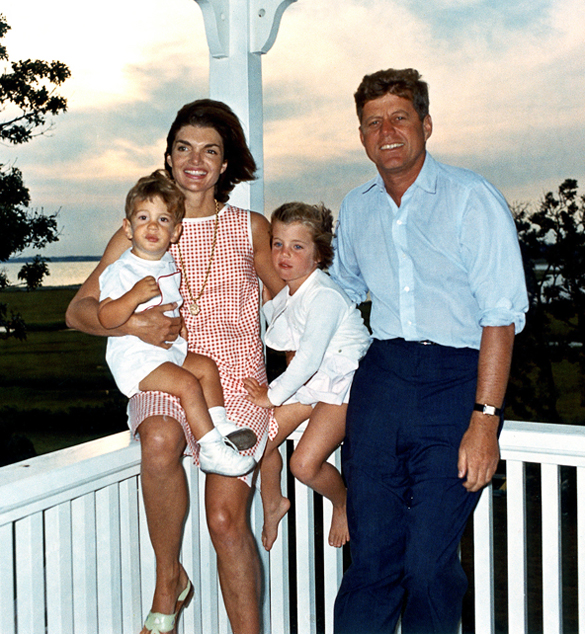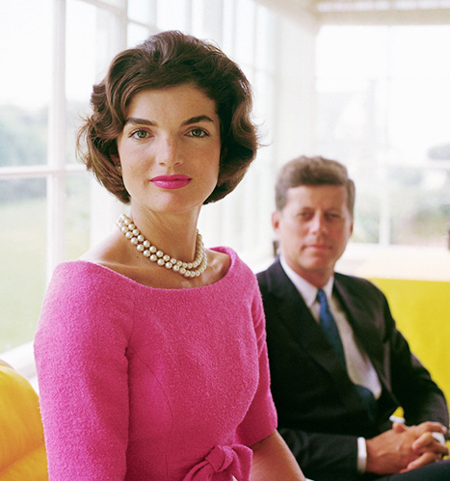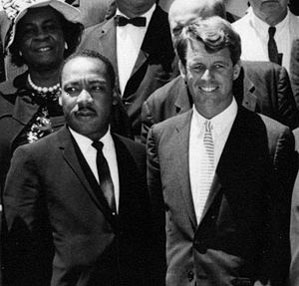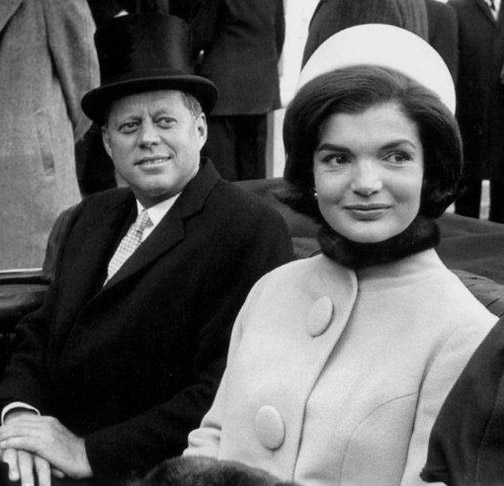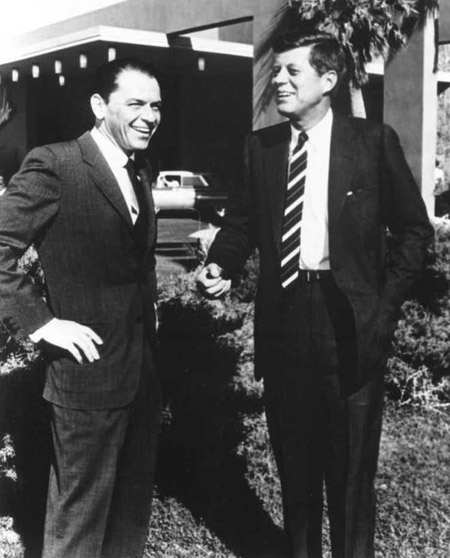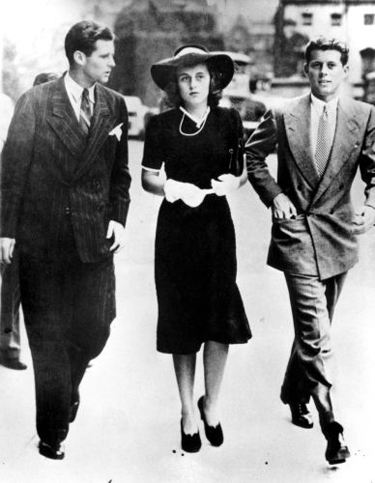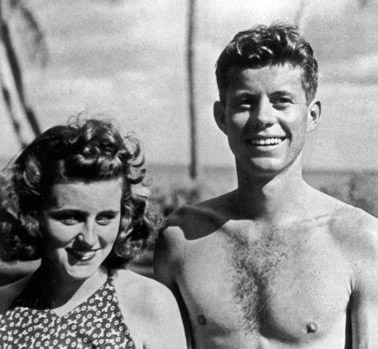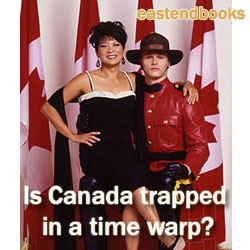Conspiracy theories, Camelot, and Glocca Morra – On the 50th anniversary of the assassination of JFK
Nov 22nd, 2013 | By Counterweights Editors | Category: In Brief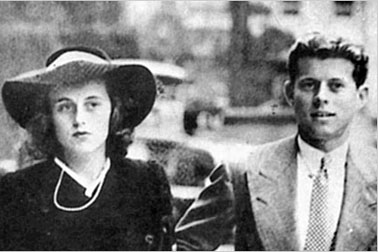
Jack Kennedy (r) and his beloved sister Kick (Kathleen), back in 1939, when no one thought he would ever be president of the USA.
This Friday, November 22, 2013 marks the 50th anniversary of the assassination of President John F. Kennedy, shortly after noon (Central Standard Time), as he rode in a motorcade through Dealey Plaza in downtown Dallas, Texas.
George Skelton recalls, in the Los Angeles Times : “Most folks in their mid-50s or older remember where they were when the flashes from Dallas stopped them in their tracks. In California, it was late morning … I was working at the state Capitol ….”
One obvious question is why should anyone still care? Last week the Gallup polling organization offered one obvious answer : “Americans Rate JFK as Top Modern President … Kennedy also received highest average approval rating while in office.”
Some will also say that the JFK assassination is still important because it opens a murky window on dark currents in American public life that are with us still (especially since the tragedy of 9/11?). Up here in Canada things may be more resolutely comedic. (As in Rob Ford and the Senate expense scandal, eg.) We are close enough to America, however, to ultimately share whatever dark currents do haunt the body politic stateside.
The official story is still that there was “No conspiracy in JFK killing; just hatred, sloppy security and a nut with a gun.” And note James Reston Jr.’s latest proposal that the assassin Lee Harvey Oswald’s intended victim was not President Kennedy at all, but Texas Governor John Connally, who was riding in the same car. Reston worries that : “If I am right that the president was not the intended target in Dallas, does that trivialize Kennedy’s death?”
At least a democratic majority of the American people, on the other hand, have never been convinced by any version of the official story, first made public in the Warren Commission report of 1964. As the Gallup organization reported last week : “Majority in US Still Believe JFK Killed in a Conspiracy …Â Mafia, federal government top list of potential conspirators.” (Oh and btw, especially up here in Canada, see also : “JFK’s assassination: Winnipeg man said he heard inside info.”)
1. Kennedy conspiracy theories
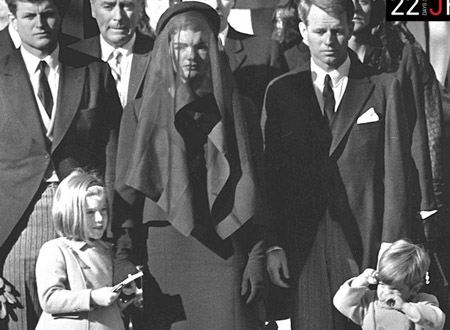 It is no doubt interesting as well that the percentage of Americans who currently think Lee Harvey Oswald was not acting alone in the assassination of President Kennedy (61%) is as low as it has been since the early 1970s. Yet even 61% is greater than the share of the popular vote won by all but one US president since the end of the Second World War. (The exception is the 61.1% that went to Lyndon Johnson, running against Barry Goldwater in 1964.)
It is no doubt interesting as well that the percentage of Americans who currently think Lee Harvey Oswald was not acting alone in the assassination of President Kennedy (61%) is as low as it has been since the early 1970s. Yet even 61% is greater than the share of the popular vote won by all but one US president since the end of the Second World War. (The exception is the 61.1% that went to Lyndon Johnson, running against Barry Goldwater in 1964.)
The part of the story that may always inspire conspiracy theories about the JFK assassination is the almost instant murder of Lee Harvey Oswald by Jack Ruby. (Or as one present-day website puts it : “The conspiracy theories really took flight the moment Jack Ruby, a seedy, two-bit nightclub owner, killed the killer, Lee Harvey Oswald, two days after Kennedy died.”)
Our theoretical counterweights editors’ manager, Dr. Randall White, also tells us he is now involved in some deep research on the rising popular political science concept of the “deep state”(soon enough to be posted somewhere on this site – perhaps??). In this connection he has bumped into the intriguing if not always easy-to-judge work of Peter Dale Scott.
According to the History Matters website, Scott “is often called the ‘dean’ of JFK assassination research, having engaged in scholarly research and writings on the topic for three decades. His landmark Deep Politics and the Death of JFK goes beyond Dealey Plaza … Dr. Scott excels at putting the assassination into the larger and too-often obscured political context …”
2. Peter Dale Scott : a brief introduction
Dr. White has stressed to us here that he reserves judgement about the work of Peter Dale Scott – until he has had more of a chance to learn more about it. But he stresses as well that Canadians at least ought to find Scott particularly intriguing.
Peter Dale Scott is the son of the Montreal poet and constitutional law professor, Frank R. Scott, who founded the League for Social Reconstruction with the Toronto historian Frank Underhill in 1932, and served as national chairman of the Co-operative Commonwealth Federation predecessor of today’s New Democratic Party, from 1942 to 1950.
Dale Scott was born in Montreal in 1929. He graduated from McGill University in 1949, with a BA in philosophy and political science. He studied in Paris and Oxford, before graduating from McGill with a PhD in political science in 1955. From 1957 to 1961 he was a foreign service officer with the Canadian Department of External Affairs. From 1961 to 1994 he taught English at the University of California at Berkeley.
Like his father he is also a poet. His “Coming to Jakarta: A Poem About Terror” has been called ”the most important political poem to appear in the English language in a very long time” by the poet-critic Robert Hass.
What the Peter Dale Scott who is “the ‘dean’ of JFK assassination research” may be pointing to, Dr. White has suggested to us, is the perhaps not excessively conspiratorial thought that the tragic death of John F. Kennedy on November 22, 1963 was only the first of three such events that left dark marks on American history in the 1960s. The other two are of course the assassinations of Martin Luther King Jr. in Memphis, Tennessee on April 4, 1968, and of Robert F. Kennedy shortly after midnight on June 5, 1968, in Los Angeles, California.
It is not unusually provocative, Dr. White (tentatively) concludes, to argue that all three of these important figures in American politics during the 1960s were trying to move American society in directions fiercely opposed by others.
It may be misleading (at best) – as the Warren Commission urged back in 1964 – to imagine that some powerful individuals among those who found the particular American dreams which Jack Kennedy, Martin Luther King, and Bobby Kennedy stood for abhorrent somehow deliberately and systematically plotted their deaths. Important purposes may nonetheless be served by serious study of the political forces in the history of the United States over the past 50 years that have systematically and aggressively attacked some kind of forward-looking American vision which John F. Kennedy has come to symbolize in many American minds.
(And it is not surprising that in the remarkable age of the internet there are – in continuing tribute to John F. Kennedy, as it were – a number of websites trying to do just that. See, eg, HERE, HERE, and HERE. Many of them at some point seem to bump into the Canadian citizen long resident in the USA, Peter Dale Scott.)
3. 1960s legend of Camelot
All this raises what seems to us the not-at-all easy question of just what the “forward-looking American vision which John F. Kennedy has come to symbolize in many American minds” is.
One too obvious answer alludes to the “Camelot Legend” that “Jackie Kennedy Invented … After JFK’s Death.” As James Piereson urged some 10 days ago on the Daily Beast website : “by far the most potent element of the Kennedy legacy was the one that associated JFK with the legend of King Arthur and Camelot. As with many of the myths and legends surrounding President Kennedy, this one was the creative contribution of [his wife] Jacqueline Kennedy who imagined and artfully circulated it in those grief-filled days following her husband’s death.”
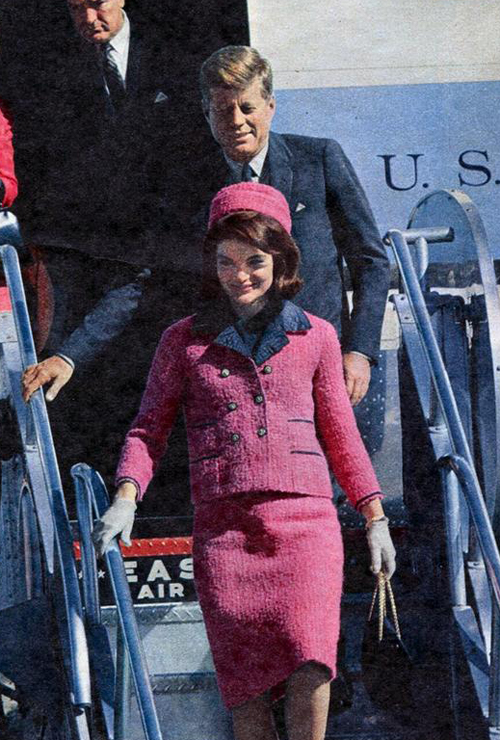 Piereson goes on : “On the weekend following the assassination and state funeral, Mrs. Kennedy invited the journalist Theodore White to the Kennedy compound in Hyannis for an exclusive interview to serve as the basis for an essay in a forthcoming issue of Life magazine …Â President Kennedy, she told the journalist, was especially fond of the music from the popular Broadway musical, Camelot, the lyrics of which were the work of Alan Jay Lerner, JFK’s classmate at Harvard. The musical, which featured Richard Burton as Arthur, Julie Andrews as Guinevere, and Robert Goulet as Lancelot, had a successful run on Broadway from 1960 to 1963.”
Piereson goes on : “On the weekend following the assassination and state funeral, Mrs. Kennedy invited the journalist Theodore White to the Kennedy compound in Hyannis for an exclusive interview to serve as the basis for an essay in a forthcoming issue of Life magazine …Â President Kennedy, she told the journalist, was especially fond of the music from the popular Broadway musical, Camelot, the lyrics of which were the work of Alan Jay Lerner, JFK’s classmate at Harvard. The musical, which featured Richard Burton as Arthur, Julie Andrews as Guinevere, and Robert Goulet as Lancelot, had a successful run on Broadway from 1960 to 1963.”
Piereson continues : “According to Mrs. Kennedy, the couple enjoyed listening to a recording of the title song before going to bed at night. JFK was especially fond of the concluding couplet: ‘Don’t ever let it be forgot, that once there was a spot, for one brief shining moment that was Camelot.’ President Kennedy, she said, was strongly attracted to the Camelot legend because he was an idealist who saw history as something made by heroes like King Arthur (a claim White knew to be untrue) … In this way, and to her credit, Mrs. Kennedy sought to attach a morally uplifting message to one of the more ugly events in American history.”
4. Kennedy family story as trace variable
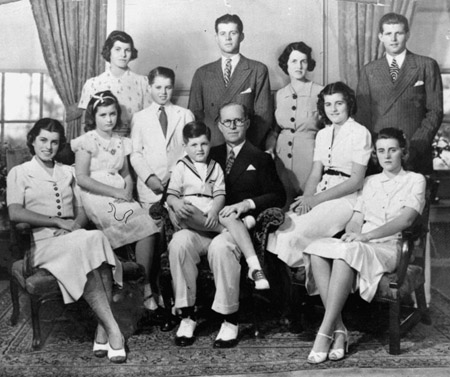
Joseph P. Kennedy and his wife Rosemary Kennedy pose with their nine children at Bronxville, N.Y., 1938. From left are, seated: Eunice, Jean, Edward (on lap of his father), Patricia, and Kathleen. Standing: Rosemary, Robert, John, Mrs. Kennedy, and Joseph, Jr. AP.
In fact, Sarah-Jane Stratford at theguardian.com explained yesterday how “Referring to JFK’s presidency as ‘Camelot’ doesn’t do him justice … The source of the Camelot reference is a story of failed idealism. It, like all mythology, distracts us from the whole story of Kennedy.”
In a recent review of two new books about John F. Kennedy’s father and mother – in the London Review of Books – Jackson Lears also focused some deeper attention on how the deeper story of Joseph P. Kennedy and Rose Fitzgerald Kennedy and their nine children serves as a kind of trace variable for one compelling strand of both light and darkness in some three generations of American history, from, say, the end of the First World War in 1918 to the election of Barack Obama in 2008 (with the ultimate support of the Kennedy clan, to Hillary Clinton’s distress).
In this deeper story the 1963 assassination of John F. Kennedy is blended with the 1968 assassination of his brother Robert. The parallel 1968 assassination of Martin Luther King can be at least only a little force-fitted into the narrative as well. It is a now often forgotten or neglected part of JFK’s legacy that he was the first Catholic president of the United States – at a time when the old WASP anglophilia of Washington, DC and the US Eastern Seaboard Aristocracy was more prominent than it is today. And all this quite arguably set the stage for the eventual triumph of the first African-American president, a mere 48 years after the election of the Catholic John F. Kennedy in the fall of 1960.
In fact again, JFK’s idealism (as Theodore White already knew when he talked with Jackie about Camelot) was tempered by many things. One of his favourite books was David Cecil’s biography of Lord Melbourne – a case study of the old English Whig aristocracy’s constructive political cynicism, first published in the later 1930s when the Kennedy clan was living in England, while father Joseph served as FDR’s US ambassador to the United Kingdom. JFK similarly was, as virtually no Washington journalist blabbed about while he was still alive, an apparently almost insatiable womanizer, like his father. And he had at least some vague Mafia associates as at least sometime friends, as in the brief 1960 election bromance with Frank Sinatra.
5. Late 1940s sadness of “How Are Things in Glocca Morra?”
The Kennedy legacy that Joseph Sr and Rose bequeathed also had its own tradition of death in the family, even before the assassinations of Jack and Bobby in the 1960s.
John F. Kennedy, as is well enough known, was not supposed to be the ambitious Joseph Kennedy Sr son who would finally become US president. That task was originally assigned to the eldest child, Joseph Kennedy Jr – a US Navy air force pilot who was killed in action in August 1944.
Less well known, but probably of more sadness for the surviving younger brother Jack, was the death of his beloved sister, Kathleen “Kick” Kennedy, in an airplane accident over France in May 1948. And here, it seems, we bump into the legend behind Maureen Dowd’s May 2011 claim that JFK’s “favorite song was ‘How Are Things in Glocca Morra?’” – from the later 1940s Broadway musical Finian’s Rainbow. As recounted in several sources :”in 1948, JFK was playing the soundtrack of the Broadway show Finian’s Rainbow when he received news that sister Kathleen had died in a plane crash. Reportedly he played Ella Logan’s How Are Things in Glocca Morra, praised her voice and turned away to weep.”
It is at this point that we (at last, after all too many ruminations) want to walk away and leave the memory of JFK in the early 21st century to the memories of all those who feel saddened, in one way or another, by the 50th anniversary occasion. (As we confess we do ourselves.)
6. “Ask not what your country can do for you”
Before we leave, here are four You Tube versions of “How Are Things in Glocca Morra?” – which Maureen Dowd at the New York Times has said was JFK’s favourite song:
(1) Ella Logan’s 1947 FinianÌs Rainbow cast recording – which JFK was apparently listening to when he first heard of his sister’s death ;
(2) A recording from (we think) more or less the same era by Bing Crosby ;
(3) Kate Baldwin’s version from a 2009 Broadway revival of Finian’s Rainbow ;
(4) A strictly instrumental version by the African American jazz tenor saxophonist Sonny Rollins, recorded in New Jersey on December 16, 1956, with Donald Byrd (trumpet); Wynton Kelly (piano); Gene Ramey (bass guitar); and Max Roach (drums) – early evidence that the 1968 assassination of Martin Luther King is part of the Kennedy legacy too.
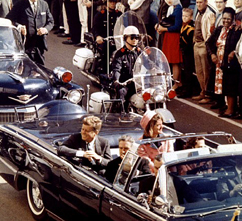
President John F Kennedy and First Lady Jackie Kennedy ride in the President's motorcade through Dallas on November 22, 1963, not long before his assassination.
Who can really say where the United States of America is headed right now? Whatever else, we remain convinced that wherever this is will not be all bad, if it continues to honour the legacy of John Fitzgerald Kennedy, who died so tragically shortly after noon (Central Standard Time), as he rode in a motorcade through Dealey Plaza in downtown Dallas, Texas, on November 22, 1963. “Ask not what your country can do for you. Ask what you can do for your country.”
